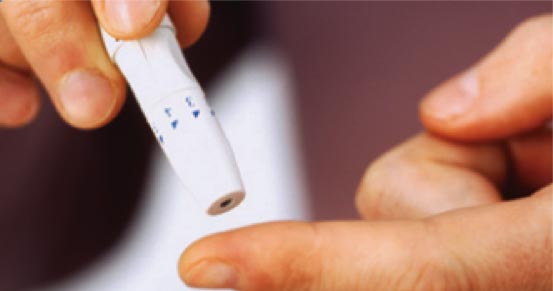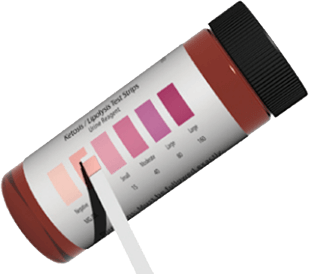Diabetic Ketoacidosis (DKA)
DKA is caused from a lack of insulin. When the body does not receive any insulin or receives too little insulin, glucose levels rise. After a period of time, the body is forced to burn fat for energy. When fat is used as the main source of energy, ketones (a waste product of fat) are produced in large amounts and accumulate in the blood. If your body does not receive insulin, DKA can develop. The length of time it takes and how high the glucose levels rise varies, however, DKA can occur within a few hours. (Note: Although DKA rarely occurs in those with type 2 diabetes, the risk is increased during severe physical stress or illness).
Checking your blood glucose (BG) regularly (4 to 6 times each day), testing more frequently when you are ill, and recognizing and responding appropriately to high glucose levels will almost always prevent DKA.
High levels of ketones are a warning sign that your diabetes is out of control or that you are getting sick. Learn more about other warning signs to help you watch out for DKA.
What are the warning signs and symptoms of DKA?
- High BG levels
- Ketones (in blood and urine)
- Nausea, vomiting, and abdominal pain (cramps)
- Confusion
- Tired, sluggish, or weak
- Flushed, hot, dry skin
- Blurred vision
- Rapid, deep breathing and shortness of breath
- Excessive thirst and frequent urination
- Fruity scented breath
- Unconsciousness

It is important to check BGs regularly.
How do I check for ketones?
Ketones are a waste product made when the body is forced to use fat instead of glucose as its main fuel (due to a lack of insulin).
You can check for ketones using a urine test or blood test, which are available at most pharmacies.
Urine test
- Collect a urine sample
- Dip ketone strip into your urine
- Check label indicators for presence of ketones. Positive ketones are indicated by small or greater ketones.

Checking for ketones is an important step in preventing the development of DKA.
Blood test
A blood test can be done with a meter or special ketone test strips. It's like testing your BG, except a ketone measurement is given. Positive ketones are indicated by a blood test that indicates the presence of Beta-Hydroxybutyrate.
Ask your healthcare professional which method is best for you.
Notify your healthcare professional if ketones are moderate to large, you have nausea or vomiting, or you have difficulty breathing.
Note: Ketones are not usually present unless you have had no insulin or inadequate amounts of insulin over a period of time, or you are ill.
What do I do if ketones are present?
- Correct high BG with insulin using a syringe
- If you use an insulin pump, change infusion site, infusion set, reservoir, and insulin, and troubleshoot pump
- Drink non-carbohydrate fluids
- Call your doctor immediately. Don’t delay!
- Seek emergency care if you can’t reach your doctor
- Follow any instructions you are given by your healthcare professional
How is DKA treated?
People with diabetic ketoacidosis need to be treated in hospital. A combination of treatments are applied to correct the high blood sugar and insulin levels.- Fluid replacement
- Insulin therapy
- Electrolyte replacement
It may take several days for your blood sugar level to return to a target range.
DKA prevention
Illness and/or infection usually cause BGs to run higher than normal. Therefore, the risk of developing DKA is increased when you are ill. Because DKA symptoms are similar to flu and stomach virus symptoms, check your BG and monitor for ketones often during illness.
- Check BG every 2 hours
- Check urine for ketones when you urinate
- Nausea or vomiting: Immediately check ketones
- Notify doctor if ketones are moderate or high
If you are too sick to monitor your diabetes carefully, ask a friend or family member to help.
The pancreas releases insulin 24 hours a day. Insulin is released in two ways: small amount (a basal) of insulin is released in between meals and while you sleep. A larger amount (bolus) of insulin is released after eating.
When you have diabetes, you may not make any insulin or not make enough insulin. So, you rely on medications to maintain glucose levels.
Read our blog for more info - How To Spot And Treat Diabetic Ketoacidosis (DKA).
Looking for more tips? Join the list
Subscribe to our newsletter, News to Infuse and receive monthly diabetes tips and helpful information.

